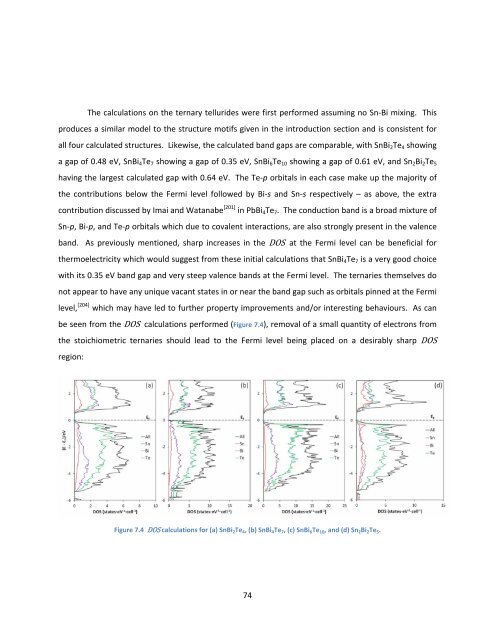Exploration and Optimization of Tellurium‐Based Thermoelectrics
Exploration and Optimization of Tellurium‐Based Thermoelectrics
Exploration and Optimization of Tellurium‐Based Thermoelectrics
Create successful ePaper yourself
Turn your PDF publications into a flip-book with our unique Google optimized e-Paper software.
The calculations on the ternary tellurides were first performed assuming no Sn‐Bi mixing. This<br />
produces a similar model to the structure motifs given in the introduction section <strong>and</strong> is consistent for<br />
all four calculated structures. Likewise, the calculated b<strong>and</strong> gaps are comparable, with SnBi2Te4 showing<br />
a gap <strong>of</strong> 0.48 eV, SnBi4Te7 showing a gap <strong>of</strong> 0.35 eV, SnBi6Te10 showing a gap <strong>of</strong> 0.61 eV, <strong>and</strong> Sn2Bi2Te5<br />
having the largest calculated gap with 0.64 eV. The Te‐p orbitals in each case make up the majority <strong>of</strong><br />
the contributions below the Fermi level followed by Bi‐s <strong>and</strong> Sn‐s respectively – as above, the extra<br />
contribution discussed by Imai <strong>and</strong> Watanabe [201] in PbBi4Te7. The conduction b<strong>and</strong> is a broad mixture <strong>of</strong><br />
Sn‐p, Bi‐p, <strong>and</strong> Te‐p orbitals which due to covalent interactions, are also strongly present in the valence<br />
b<strong>and</strong>. As previously mentioned, sharp increases in the DOS at the Fermi level can be beneficial for<br />
thermoelectricity which would suggest from these initial calculations that SnBi4Te7 is a very good choice<br />
with its 0.35 eV b<strong>and</strong> gap <strong>and</strong> very steep valence b<strong>and</strong>s at the Fermi level. The ternaries themselves do<br />
not appear to have any unique vacant states in or near the b<strong>and</strong> gap such as orbitals pinned at the Fermi<br />
level, [204] which may have led to further property improvements <strong>and</strong>/or interesting behaviours. As can<br />
be seen from the DOS calculations performed (Figure 7.4), removal <strong>of</strong> a small quantity <strong>of</strong> electrons from<br />
the stoichiometric ternaries should lead to the Fermi level being placed on a desirably sharp DOS<br />
region:<br />
Figure 7.4 DOS calculations for (a) SnBi 2Te 4, (b) SnBi 4Te 7, (c) SnBi 6Te 10, <strong>and</strong> (d) Sn 2Bi 2Te 5.<br />
74
















